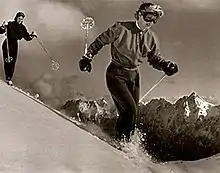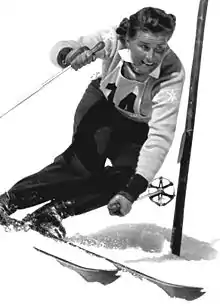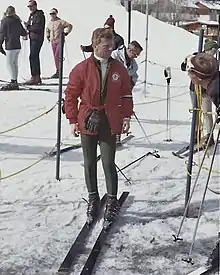Maria Bogner
Maria Bogner (née Lux, 1914 – 17 November 2002) was a German fashion designer credited with developing practical stretch pants, thereby profoundly affecting the direction of the ski fashion industry. She created colorful, sexy, and functional stretchy skiwear. Her husband's established ski apparel company, the development of stretch material in the 1950s, and her sewing skills all contributed to her success. Her stretch pants, as modeled by leading ski athletes of the period, provided aerodynamic, form-fitting cut, color variety and practicality as ski garments.[1]
Maria Bogner | |
|---|---|
 Bogner and sister modeling her ski apparel ca. late 1940s. | |
| Born | Maria Lux 1914 Cologne, Germany |
| Died | 17 November 2002 (aged 87–88) Tegernsee, Germany |
| Occupation | Fashion designer |
| Years active | 1932-1972 |
| Employer(s) | Willy Bogner, GMBH |
| Spouse(s) | Willy Bogner, Sr. |
| Children | 3 |
Personal life

Bogner was born Maria Lux in 1914 in Cologne and died on 17 November 2002 in Tegernsee.[1] In 1937 she married Wilhelm Bogner (Willy Sr.), a German Nordic combined ski champion who competed in the 1930s. Together, they had three children, Rosemarie, Michael, and Wilhelm (Willy Jr.).[2] Willy Bogner's success as a skier allowed him and his future wife, then Maria Lux, to establish a clothing line in 1932, that included outfitting the German national ski team at the 1936 Winter Olympics.[3]
Her husband died in 1977 and she died in 2002.[4]
Career
Pre-WWII
Skiing Magazine called Bogner, “the mother of modern ski fashion”, citing her outsized influence as a woman on ski culture.[3] Her career began with the development of novel ski garments in the early 1930s and was interrupted by World War II.
In 1936 Bogner created an anorak (parka) for the German Olympic ski team of which her fiancé was a member.[2] After their marriage, Bogner became involved in the fashion side of her husband's business, which included importing ski equipment. In addition to ski apparel, they designed and manufactured blouses, traditional Bavarian dresses, as well as hiking apparel.[5] The growth of their business was interrupted by WWII and her husband's internment by the US.[4]

Post-WWII
After the war her ski fashion innovations in style and color, especially with stretch pants, allowed the Bogner business to flourish in the upscale ski apparel market. While her husband was away and in order to support her three children, Bogner continued to design colorful anoraks that were sold by the thousands.[4] In addition to creating and selling parkas, Bogner also began rebuilding the business by creating other products, such as aprons.[4] In 1950, the Bogners began exporting their colorful products to the US, including Bogner's parkas.[6] In 1955 Bogner began branding the company with a logo, styled as a “B”, on all zippers found on their clothing.[7]
Early 1950s, stretch pants
In the early 1950s, the Bogners were manufacturing ski pants in gabardine fabric. They were distinctive both for their durability and the wide choice of bright, appealing colors—a break from the previous standards of black, blue and forest green.[4] In 1951, a Bianchini-Férier (fr) textile representative introduced Bogner to a new material, with a crimp elasticized yarn,[8] developed by the Swiss company, Heberlein (de),[9][10] and marketed under the name, Helanca (cs de), which was incorporated into a prototype pair of ski pants.[11][12] Helanca was a blend of wool and a springy, coiled nylon fiber, which allowed the material to stretch and be durable through multiple wash cycles.[13][14] The problem was how to sew it successfully, which Bogner solved. Early examples of her stretch pants lost their resiliency after a few seasons. This problem was solved such that by 1955,[15] she was exporting them to the US in 42 different colors. The pants were highly successful, despite costing double what conventional ski pants cost at the time, thanks to their aerodynamic, sexy, form-fitting[16] cut and wide variety of colors. The product was marketed effectively in catalogs and advertisements, using attractive young women and celebrity athletes, such as Stein Eriksen, as models.[4]
1960s to retirement
The publicity and advertising of the Bogner line of up-scale fashion made it the choice of such celebrity consumers of ski apparel as, Marilyn Monroe, Ingrid Bergman, the Shah of Iran, and Toni Sailer. Bogner apparel was also in demand by ski teams for its aerodynamic efficiency and warmth. By the mid-1960s, many other companies were producing stretch pants.[12] Bogner remained active in the company until the early 1970s, when her sons, Michael and Willy Jr., took over the business.[4]
Legacy
Bogner's creation was so widely recognized that she was featured on the cover of the November 1955 issue of Ski Magazine, wearing her ski apparel.[12] In its 1995 "Skiing for Women" issue, Skiing magazine cited Bogner as a skiing "legend", along with Andrea Mead Lawrence and Martha Rockwell[3]
References
- Allen, E. John B. (2011). Historical Dictionary of Skiing. Lanham, Maryland: Scarecrow Press. ISBN 9780810879775.
- Terrell, Roy (February 6, 1961). "They Make the Pants". Sports Illustrated. Retrieved 2018-03-14.
- "Legends: Maria Bogner – For changing the look of skiing forever". Skiing. New York: Ziff-Davis (Skiing for Women): 50. 1995. ISSN 0037-6264. Retrieved 2018-02-17.
- Masia, Seth (September 2002). "The 50th anniversary of stretch pants". Skiing Heritage Journal. International Skiing History Association. 14 (3): 35–6. ISSN 1082-2895.
- Editors. "Bogner". fashionmodeldirectory.com. Fashion Mode Directory. Retrieved 2018-03-15.
{{cite web}}:|last=has generic name (help) - Lert, Wolfgang (Autumn 1996). "The Finish Line: Hans Hagemeister brought us good things to ski with". Skiing Heritage Journal. 8 (3): 38–39. ISSN 1082-2895.
- Editors. "Bogner Company History". en.bogner.com. Retrieved 2018-03-15.
{{cite web}}:|last=has generic name (help) - "Helanca". fashion.mam-e.it (in Italian). MAM-E srls. 2016-01-16. Retrieved 29 May 2021.
Trademark belonging to the Swiss company Heberlein & Co. for a crimp elasticized yarn with continuous filaments, usually made of nylon, and mostly used for hosiery and knit undergarments.
- "HELANCA Trademark Detail". Zauba Corp. 1956-04-06. Retrieved 29 May 2021.
Heberlein & Co. Aktiengesellschaft ... WATTWIL, SWITZERLAND.
- "history timeline: 1951". Heberlein. Retrieved 29 May 2021.
1951. Start of Helanca® yarn manufacture from fully synthetic filament yarn (nylon)
- Masia, Seth. "Maria Bogner and the stretch pant". International Skiing History Association. Retrieved 29 May 2021.
The first of the these blends was developed in Switzerland, in the early '30s, by an American, Rudolph Kaegi. He spun the acetate fiber Celanese into a springy spiral, then wove it with wool to produce the first stretch fabric. The material was licensed and marketed by Heberlein & Co., under the brand name Helanca. The stuff worked, for a short while, but lost its stretch when washed. After World War II, nylon became available to European mills in commercial quantities. Heberlein redesigned Helanca using the new, more waterproof synthetic. It worked better, and stood up longer to laundering. This is the fabric Maria Bogner first saw in 1951. An even better version was developed in French mills in the late '50s, using nylon threads coiled both to the left and to the right. Bogner's first pants were made of the original Helanca nylon/wool blend, and while they looked great, they lost resilience within a couple of seasons.
- McCoy, Susan (September 1983). "A stretch in the right direction". Ski Magazine. New York: Times Mirror Magazines, Inc. 48: 162. ISSN 0037-6159.
- Hearle, J W S; Hollick, L; Wilson, D K (2001). "1. The origins of texturing". Yarn texturing technology.
The invention of the false-twist process of twisting, setting and untwisting by Finlayson at Celanese led to textured acetate yarns for hand-knitting, and by Heberlein to the use of textured viscose rayon during the 1939–45 war. However, the set of cellulosic yarns is easily lost; the crimp can be pulled out. The market for these forms of textured rayon and acetate did not survive. It was the 'permanent set' of nylon that led to the commercial success of yarn texturing. At first, it was thought necessary to set nylon in steam, so the continuous false-twist process was not used. Heberlein developed a long, multistage process with setting in an autoclave. Despite the high cost, their Helanca yarns were a great success because the elastic extensibility up to around 400% made them excellent for stretch stockings, men's socks, swimwear and other form-fitting garments.
- "Helanca". Deutsches StrumpfMuseum. 2001-07-15. Archived from the original on 2001-07-15. Retrieved 29 May 2021.
google translate: In 1931, the American Rudolph H. Kägi presented the result of months of experiments, a new yarn, to the head of the American branch of the Swiss company Heberlein & Co. Mister Kägi was a twisting specialist and had developed a new process for the artificial silk fibers that had previously only been processed smoothly, from which the smooth fibers take on the character of wool by curling up, fixing and turning back.
- "US2895288 Production of bulky colorspun rayon yarn". patents.google.com. 1956-09-21. Retrieved 29 May 2021.
- Staff (March 9, 1964). "Action". Vault. Sports Illustrated. Retrieved 29 May 2021.
Man-made stretch fabrics can be classified in three main groups. False twist: Helanca, a process of twisting nylon yarn, heat-setting it and untwisting it before weaving, was the forerunner of this group. Developed by a Swiss firm, Heberlein, Helanca stretch nylon-and-wool was first used in ski pants by the Bogners in 1952. Since then other firms using twist and heat-set methods have created similar stretch yarns, which are called, as a group, false twist
External links
- History at Bogner official website
- Bogner modeling her anorak at Bogner official website